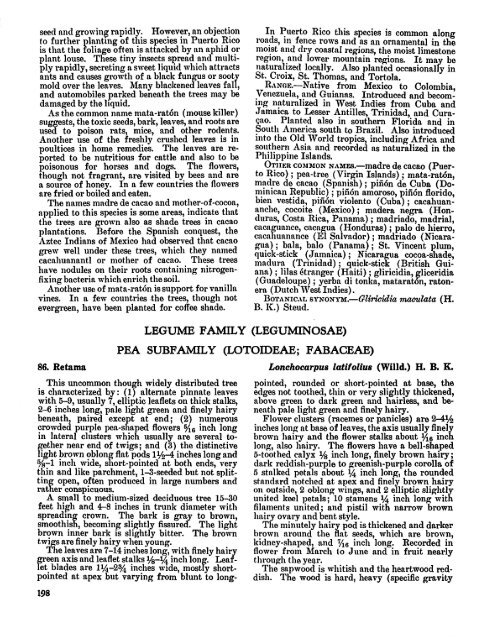Common Trees of Puerto Rico and the Virgin Islands
Common Trees of Puerto Rico and the Virgin Islands
Common Trees of Puerto Rico and the Virgin Islands
Create successful ePaper yourself
Turn your PDF publications into a flip-book with our unique Google optimized e-Paper software.
seed <strong>and</strong> growing rapidly. However, an objection<br />
to fur<strong>the</strong>r lantlng <strong>of</strong> this species in <strong>Puerto</strong> <strong>Rico</strong><br />
is that <strong>the</strong> ! oliage <strong>of</strong>ten is attacked by an aphid or<br />
plant louse. These tiny insects spread <strong>and</strong> multiply<br />
rapidly, secreting a sweet liquid wl~ich attracts<br />
ants <strong>and</strong> causes growth <strong>of</strong> a black fungus or soot<br />
mold over <strong>the</strong> leaves. &Mny blackened leaves fall:<br />
<strong>and</strong> automobiles parked beneath <strong>the</strong> trees may be<br />
damaged by <strong>the</strong> Ilquid.<br />
As <strong>the</strong> commo? name mata-rathn (mouse killer)<br />
suggests, <strong>the</strong> toxic seeds, bark, leaves, <strong>and</strong> roots are<br />
used to poison rats, mice, <strong>and</strong> o<strong>the</strong>r rodents.<br />
Ano<strong>the</strong>r use <strong>of</strong> <strong>the</strong> freshly crushed leaves is in<br />
poultices in home remedies. The leaves are reported<br />
to be nutritious for cattle <strong>and</strong> also to be<br />
poisonous for horses <strong>and</strong> dog. The flowers,<br />
though not fragrant, are visited by bees <strong>and</strong> are<br />
a source <strong>of</strong> honey. In a fen. countries <strong>the</strong> flowers<br />
are fried or boiled <strong>and</strong> eaten.<br />
The names madre de cacao <strong>and</strong> mo<strong>the</strong>r-<strong>of</strong>-cocoa,<br />
applied to this species is some areas, indicate that<br />
<strong>the</strong> trees are grown also as shade trees in cacao<br />
plantations. Before <strong>the</strong> Spanish conquest, <strong>the</strong><br />
Aztec Indians <strong>of</strong> Mexico had observed that cacao<br />
grew well under <strong>the</strong>se trees, which <strong>the</strong>y named<br />
cacahuanantl or mo<strong>the</strong>r <strong>of</strong> cacao. These trees<br />
have nodules on <strong>the</strong>ir roots containing nitrogenfixing<br />
bacteria which enrich <strong>the</strong> soil.<br />
Ano<strong>the</strong>r use <strong>of</strong> mata-xatbn is support for vanilla<br />
vines. In a few countries <strong>the</strong> trees, though not<br />
evergreen, have been planted for c<strong>of</strong>fee shade.<br />
In <strong>Puerto</strong> <strong>Rico</strong> this species is common along<br />
roads, in fence rows <strong>and</strong> as an ornamental in <strong>the</strong><br />
moist <strong>and</strong> dry coastaI regions, <strong>the</strong> moist limestone<br />
region, <strong>and</strong> lower mountain regions. It may be<br />
naturalized locally. Also planted occasionaliy in<br />
St. Croix, St. Thomas, <strong>and</strong> Tortola.<br />
RANGE.-Native from Mexico to Colombia,<br />
Venezuela, <strong>and</strong> Guianas. Introduced <strong>and</strong> becoming<br />
naturalized in West Indies from Cuba <strong>and</strong><br />
Jamaica to Lesser Antilles, Trinidad, <strong>and</strong> Curacao.<br />
Planted also in sou<strong>the</strong>rn Florida <strong>and</strong> in<br />
South America south to Brazil. Also introduced<br />
into <strong>the</strong> Old MTorld tropics, including Africa <strong>and</strong><br />
soi~<strong>the</strong>rxi Asia <strong>and</strong> recorded as naturalized in <strong>the</strong><br />
Philippine Isl<strong>and</strong>s.<br />
OTHER<br />
COMBZON NAB~ES.-madre<br />
LEGUME FAMILY (LEGUMINOSAE)<br />
de cacao (Puer-<br />
to <strong>Rico</strong>) ; pea-tree (<strong>Virgin</strong> Isl<strong>and</strong>s) ; mata-rat6n,<br />
mndre de cacao (Spanish) ; pifi6n de Cuba (Dominican<br />
Republic) ; pifi6n amaroso, pifi6n florido,<br />
bien vestida, pi5611 violento (Cuba) ; cacahuananche,<br />
cocoite (Mexico) ; madem nep (Honduras,<br />
Costa Rica, Panama) ; madriado, madrial,<br />
caca lance, cacngua Honduras) ; palo de hierro,<br />
a~ca P" luannnce (El Sa \ vador) ; madrlado (Nicaragun)<br />
; bala, balo (Panama) ; St. Vincent plum,<br />
quick-stick (Jamaica) ; Nicaragua cocoa-shade,<br />
madura (Trinidad) ; quick-stick (British Guiana)<br />
; lilas Btranger (Haiti) ; gliricidin, gliceridia<br />
(Guadeloupe) ; yerba di tonka, mataraton, ratonera<br />
(Dutch West Indies).<br />
BOTANICAL GYNONPM.-G~~~~!~&~<br />
B. IC.) Steud.<br />
mdcuikta (H.<br />
PEA SUBFAMILY (LOTOIDEAE; FABACEAE)<br />
86. Retama Lonchocarpus latifolius (Willd.) H. B. K.<br />
This uncommon though widely distributed tree<br />
is characterized by : (1) alternate pinnate leaves<br />
with 5-9, usually 7, elliptic leaflets on thick stalks,<br />
2-6 inches long, pale light green <strong>and</strong> finely hairy<br />
beneath, paired exce t at end; (2) numerous<br />
crowded purple pen-s f lnped flowers 6/,, inch long<br />
in lateral clusters which usually are several toge<strong>the</strong>r<br />
near end <strong>of</strong> twigs; <strong>and</strong> (3) <strong>the</strong> distinctive<br />
light bromn oblon flat pods 11/24 inches long <strong>and</strong><br />
y8-1 inch wide, s f lort-pointed at both ends, very<br />
thin <strong>and</strong> like parchment, 13-seeded but not splittin<br />
open, <strong>of</strong>ten produced in large numbers <strong>and</strong><br />
rat f; er conspicuous.<br />
A small to medium-sized deciduous tree 15-30<br />
feet high <strong>and</strong> 4-8 inches in trunk diameter with<br />
crown. The bark is gra to brown,<br />
smoothis , becoming slightly fissure2 The light<br />
brown inner bark is slightly bitter. The brown<br />
twigs are finely hairy when young.<br />
The leaves are 7-14 inches long, with finely hairy<br />
green axis <strong>and</strong> leaflet stalks l/g-% inch Ion . Leaflet<br />
blades are ll/q-2y$ inches wde, most f y shortpointed<br />
at apex but varying from blunt to long-<br />
pointed, rounded or short-pointed at base, <strong>the</strong><br />
edges not too<strong>the</strong>d, thin or very slightly thickened,<br />
above green to dark green <strong>and</strong> hairless, <strong>and</strong> be-<br />
neath pale light green <strong>and</strong> finely hairy.<br />
Flower clusters (racemes or panicles) are 24%<br />
inches long at base <strong>of</strong> leaves, <strong>the</strong> axis usually finel<br />
brown hairy <strong>and</strong> <strong>the</strong> flower stalks about l/le inc K<br />
long, also hairy. The flowers have a bell-shaped<br />
5-too<strong>the</strong>d calyx 4/8 inch long, finely brown hairy;<br />
dark reddish-purple to ,mnish-purple corolla <strong>of</strong><br />
5 stalked petals about 1/4 inch long, <strong>the</strong> rounded<br />
st<strong>and</strong>ard notched at apex <strong>and</strong> finely brown hairy<br />
on outside, 2 oblong wings, <strong>and</strong> 2 elliptic slightly<br />
united Ireel petals; 10 stamens inch long with<br />
filaments united; <strong>and</strong> pistil with narrow brown<br />
hairy ovary <strong>and</strong> bent style.<br />
The minutely hairy pod is thickened <strong>and</strong> darker<br />
bromn around <strong>the</strong> flat seeds, which are bromn,<br />
kidney-shaped, <strong>and</strong> 7/la inch long. Recorded in<br />
flower from March to June <strong>and</strong> in fruit nearly<br />
through <strong>the</strong> year.<br />
The sapwood is whitish <strong>and</strong> <strong>the</strong> heartwood red-<br />
dish. The wood is hard, heavy (specific gravity

















